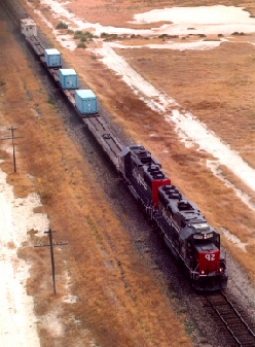 Foreign Research Reactor Fuel Shipped Through Nevada
Foreign Research Reactor Fuel Shipped Through Nevada
In 1953 the United States made an agreement under the Atoms for Peace Program to supply nuclear research reactor technology to countries that agreed to use it only for medical research and other peaceful means. Under this agreement, the U.S. committed to take back the spent reactor fuel to ensure that it was not reprocessed and used to produce nuclear weapons by terrorists or rogue governments.
After completing a detailed environmental study on the issue, the Department of Energy (DOE) in cooperation with the Department of State made a decision to ship the spent fuel from 41 participating countries back to the U.S. The current plan calls for the fuel to be shipped to the U.S. over a thirteen year period ending in 2009.
The highly radioactive spent fuel will be transported to the U.S. by sea and enter the country in two places. The east coast is receiving the fuel at the Charleston Naval Weapons Station in South Carolina where it is shipped to the Savannah River Site for temporary storage. The amount of fuel shipped to the east coast will total about 19 metric tons.
The west coast receives fuel from Asia and the Pacific Rim countries at the Concord Naval Weapons Station near San Francisco, California. From there the fuel is shipped to Idaho for temporary storage at DOE’s Idaho National Engineering and Environmental Laboratory (INEEL). Shipments from Concord to Idaho are by rail and will only total about 1 metric ton.
DOE anticipates there will be five shipments, or about 15 casks, of spent reactor fuel routed through California and Nevada to Idaho. The route passes directly through Nevada and Eureka County on the Union Pacific line. In the future, if Yucca Mountain is approved as a repository for civilian spent fuel and high-level waste, DOE plans to permanently dispose of all the foreign reactor fuel there. Conceivably then, the fuel could again be transported through Nevada on its way to Yucca Mountain.
En route to INEEL, the spent fuel is shipped in Type B transportation casks approved by the Nuclear Regulatory Commission (NRC) and certified by the Department of Transportation (DOT). To meet NRC standards, the casks must be able to limit emitted radiation to allowable levels of 200 millirem per hour on the package surface and 10 millirem per hour at a distance of two meters (6.6 feet), even in the case of an extreme accident.
DOE officials hold that the likelihood of an accident resulting in the release of radiation into the atmosphere is incredibly small. They point to their transportation record of radioactive substances: a total of only a half-dozen accidents in 2,500 shipments over the years, and not one of these accidents resulted in the release of radioactivity.
Yet, spent fuel transportation does not come without controversy -- especially on the west coast. Residents of both California and Nevada have been protesting the shipments of reactor fuel. Activist groups discovered that DOE may not have conducted thorough enough tests on the fuel shipping casks. In the first week of July, DOE responded to a report issued by Citizen Alert, a Nevada based environmental organization, by admitting the shipping casks have undergone only computer simulations and quarter-scale model tests, and that real life tests are not planned.
Citizens are concerned with routing, such as the pass through Feather River Canyon, an area prone to frequent landslides due to the abnormally large amount of snowfall this past winter. On May 30 of this year a train was derailed in the area, spilling its contents all over the tracks. Fortunately, that particular train was only carrying tequila and wine instead of highly radioactive spent fuel.
The first of the five shipments arrived in the Bay Area on July 22 and was transported through Nevada to Idaho the next day. The spent nuclear fuel met some peaceful anti-nuke protesters in San Francisco, made it safely through Feather River Canyon, and reached its Idaho destination safely on July 23.
Because the Union Pacific line passes through Beowawe, the residents of Eureka County are also affected by the shipments. State and local emergency response personnel, in conjunction with the railroad and federal officials from DOE and DOT, would respond if there were an accident involving the research reactor fuel shipments. |